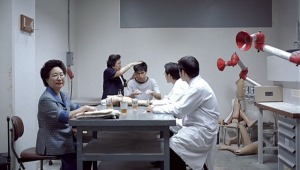The Poetic Vehicle of Authoritarian Ideology
(note: I may use gender-neutral “they,” “them,” “their,” and/or “theirs” to refer to anonymous imagined persons)
Benjamin’s view seems to be that technology and geopolitics have formed a situation by which people’s discontent, paired with their lack of connection to reality, has opened a space available to exploitation by authoritarians. Today, we might see this as a Žižekian point: effective authoritarians often rely on poetry to motivate the masses to comply with unspeakable terrors[1]. This poetry relies on the emptying of ideological space. Benjamin’s historical dialectics proposes that modern consumption of art entails the effacement of artworks’ material and ritual aspects that initially are artworks’ raison d’etre. In modernity, the roles of art and culture are hollowed out in a way that recalls Marx’s line from The Eighteenth Brumaire: “Hegel remarks somewhere that all facts and personages of great importance in world history occur, so to speak, twice. He forgot to add: the first time as tragedy, the second as farce.”[2] For Benjamin, this appears in the difference between myth and allegory: myths are stories born of people’s common material experiences and conditions, whereas allegories are tales meant to instill bourgeois ideals and practices agreeable to the ruling class.
Part of the problem is that technology and capitalism have cheapened people’s experiences. In “On Some Motifs in Baudelaire,” Benjamin says, “Since the end of the nineteenth century, philosophy has made a series of attempts to grasp ‘true’ experience, as opposed to the kind that manifests itself in the standardized, denatured life of the civilized masses.” (314) People’s experiences no longer appear to be authentic and fulfilling. Further down the page, Benjamin refers to Bergson’s relationship to the problem as expressed in Bergson’s Matière et Memoire (Matter and Memory): “As the title suggests, it regards the structure of memory as decisive for the philosophical structure of experience. […] [Experience] is the product less of facts firmly anchored in memory than of accumulated and frequently unconscious data that flow together in memory.” Memory, then, is partly determined by unconscious information that informs everything that we do, including thought. In V. N. Vološinov’s Marxism and the Philosophy of Language[3], he fleshes out a similar idea. On p. 10, he says, “The domain of ideology coincides with the domain of signs. They equate with one another. Wherever a sign is present, ideology is present, too.” For Vološinov, all use of language necessitates what Benjamin calls “unconscious data.” Later in the book, Vološinov determines that individuals’ uses of signs rely on social construction. Members of groups of people mutually agree upon the meanings of signs. All signs reflect understandings of the world determined by the group of people who construct that particular system of signs. Signs facilitate these system formations. The process of forming these systems always already includes ideology, even before any sign is constructed.
The same signs often appear in different, contemporaneous systems. The constructions of these differing systems of signs depend on the situations in which people find themselves. Any group of people might understand a sign differently from any other group of people. In any geographical place, the proletariat at any point in time can, and often does, construct a different meaning for any particular sign than that which the bourgeoisie might construct. These signs help to determine how we view ourselves, so all aspects of the individual are partly determined by the community.
When Benjamin says, “Experience is indeed a matter of tradition, in collective existence as well as private life,” (314) he highlights how socially constructed signs inform the construction of the individual but also how these signs construct our understandings of past events. Throughout Benjamin’s writing, he points out that understandings of history are determined by interpretations of past events. Illegible and inconvenient parts of histories are removed, while recollectors of histories imbue positive content-values: what Vološinov calls “ideology” and what Benjamin calls “unconscious data.”
To return to the beginning of this essay, what is imbued in these histories can be a bit of Žižek’s authoritarian poetry—a concern that Žižek and Benjamin seem to share. As the authoritarian’s poetry determines the interpretation of history, it also determines how individuals define themselves in and against their communities.
[1] For example, see Slavoj Žižek’s “The Poetic Torture-House of Language,” Poetry. Chicago: Poetry Foundation. 2017. https://www.poetryfoundation.org/poetrymagazine/articles/70096/the-poetic-torture-house-of-language
[2] Marx, Karl. The Eighteenth Brumaire of Louis Bonaparte. Moscow: Progress Publishers. 1934. 10.
[3] Vološinov, V. N. Marxism and the Philosophy of Language. New York: Seminar Press. 1973.
Benjamin, Walter. “On Some Motifs in Baudelaire.” Walter Benjamin, Selected Writings, Vol. 2. Cambridge, MA: The Belknap Press of Harvard University Press. 1966. 313-55.



